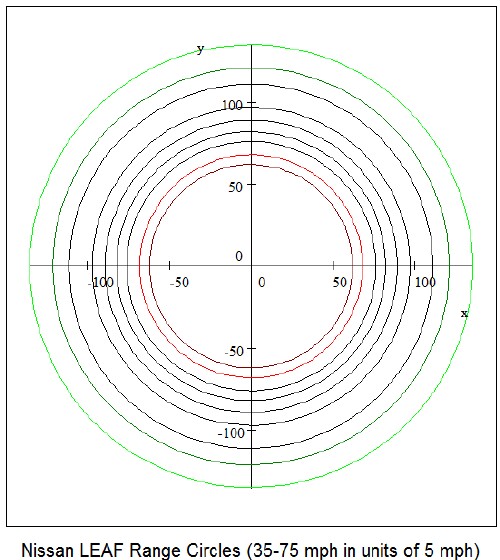
The axes units are miles.
http://www.roperld.com/science/ElectricCarsMusings.pdf
Diary of a Nissan LEAF Owner
Why he bought a LEAF
A happy LEAF driver
LEAF=Leading Environmentally-friendly Affordable Family car!
Nissan LEAF named Europe's Car of the Year for 2010
Nissan LEAF named 2011 World Car of the Year
Cars.com named Nissan LEAF Eco-Friendly Car of the Year for 2013
Interview with Carlos Ghosn, Nissan CEO, about the LEAF
NPR interview with Carlos Ghosn in a LEAF
The Nissan LEAF is a electric vehicle that provides excellent driving throughout a region of radius less than 138 miles at a minimum speed 35 mph. The range radii for different speeds on flat ground at moderate temperatures are given by:

The axes units are miles.
The graph shows that, at a high speed 75 mph, the flat-ground range is ~ 63 miles.
Of course, if one drives to the limit of the range, a full charge would have to be done to get back home.
Check the official documentation for items listed here to be sure and in case of changes.
Battery voltage: |
403.2 volts/360 volts nominal
|
Battery cells: |
48 NEC modules with 4 manganese-oxide Li-ion cells/module in pairs (NMC cells) |
Battery weight: |
648 lb (294 kg) |
Battery energy/power: |
24 kWh/90 kW (~21 kWh useable) |
Battery temperature: |
air controlled & heater (2012) for cold weather |
Battery replace: |
<77%, degrades ~80% in 10 years; bad module can be replaced |
Charger power: |
3.3 kW (2013 upgrade to 6.6 kW) |
Charging time: |
Level-1: 120-V 12-A maximum: 20 hours; |
Motor power/torque: |
80 kW/107 hp synchronous/280 N-m (254 N-m for 2013) |
Motor to Wheels gear ratio: |
8:1 |
Motor voltage: |
~400 V |
Range: |
~84 miles for 2013 fully charged ~10% increase (~92 miles) in ECO mode |
90 mph |
|
Battery warranty: |
battery: 100,000 miles/8 years; does not include degrading 80% in 8 years |
Vehicle warranty: |
3 years or 36,000 miles Powertrain: 5 years or 60,000 miles |
Dimensions: |
Length: 14'7", Width: 5'6", Height: 5'1" |
3354 lbs (1521 kg) (Front: 49%, Rear: 51%) Max. passengers & cargo: 1400 lbs |
|
Ground clearance: |
6.3" |
0.28 |
|
Tires: |
Bridgestone Ecopia all-season EP422 205/55R16 |
Tire pressure: |
36 psi front & rear |
Turning circle: |
34.2' |
Features: |
|
MSRP: |
2012: $35,200/$37,250 (-$7,500 US tax credit) |
http://www.nissanusa.com/electric-cars/leaf/features/
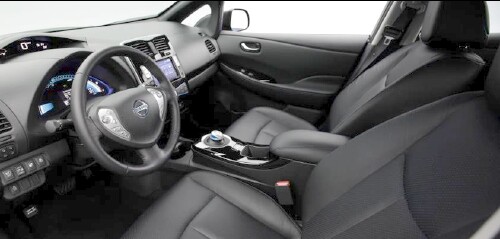
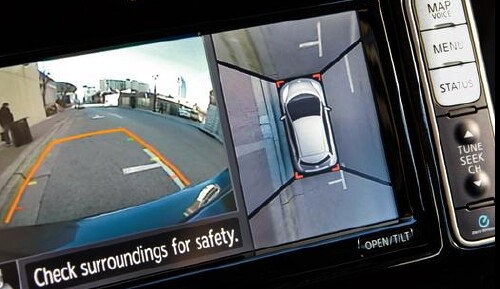
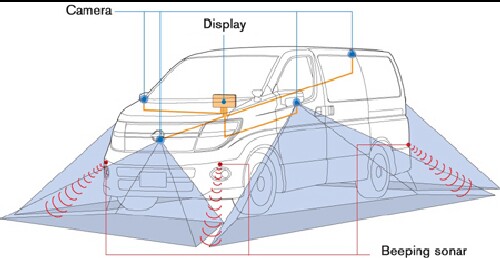
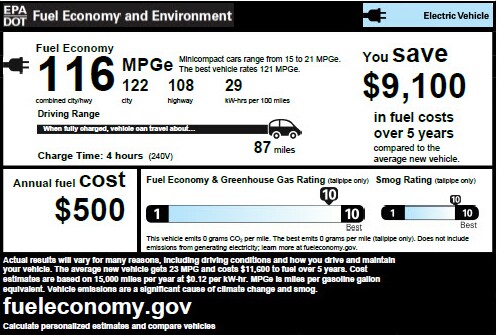
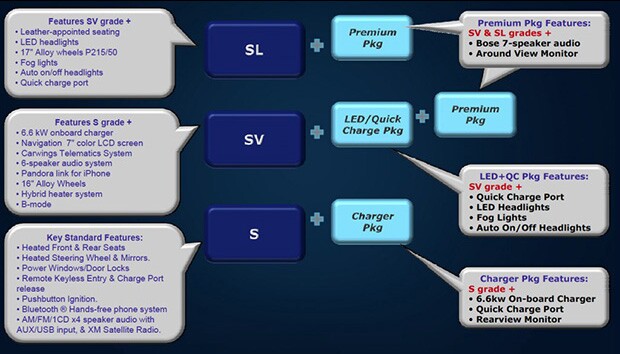
http://insideevs.com/comprehensive-video-overview-2016-nissan-leaf-sl-wpremium-package/
The humps that contain the headlights cause the air flow to bypass the side mirrors. (http://www.mynissanleaf.com/viewtopic.php?f=8&t=6836 ):
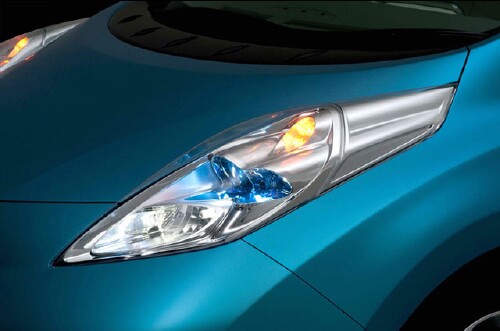 |
 |
 |
Side-mirrors air turbulence is a major cause of vehicle drag.
Clean Fleet Report: The LEAF SV model includes an advanced GPS navigation system. You can control and monitor battery charging and even pre-heat/pre-cool and charging control with your smart phone. The LEAF has Internet/smart phone connectivity to the vehicle, and, Bluetooth connectivity; intelligent-key with push button start, Sirius/XM satellite radio capabilities, and roadside assistance with the vehicle wirelessly notifying a support center. The SL model also includes a rearview monitor, solar panel spoiler which supplies a trickle charge, fog lights, and automatic headlights. The 2012 SL model includes the DC Fast Charge port (level-2 240-volts 30 amps maximum). Nissan has doubled the charge rate in the 2012 model. 3-years of roadside assistance including in price. Tire pressure monitoring system (TPMS). SL Model review monitor provides a video display of the rear camera for safer backups and parking. Much of this electric car is designed for recycling, and recycled materials are used in building the car. 98 percent of the lithium batteries are expected to be reused in stationary applications or recycled. Nissan LEAF makes extensive use of recycled and recyclable materials, such as seat fabric, instrument panel materials, and front- and rear-bumper fascias. The LED head lights reduce battery demand at night.
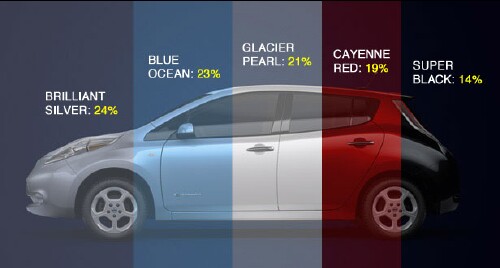
These are the five colors available for 2011 & 2012. More colors will probably be available for the LEAFs to be built later in Smyrna TN.
City driving: |
effective 106 mpg |
Highway driving: |
effective 92 mpg |
Range: |
73 miles |
Yearly cost: |
$561 |
Charging time: |
7 hours @ 240 volts |
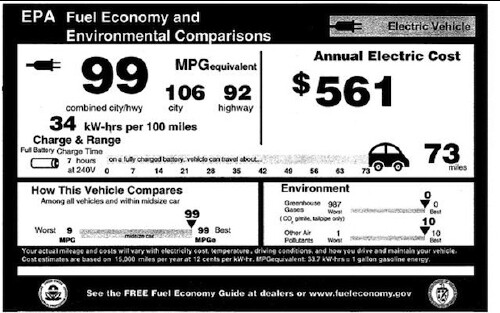
The 24-kWh traction battery is manganese-oxide-lithium ion.
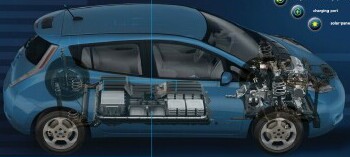 |
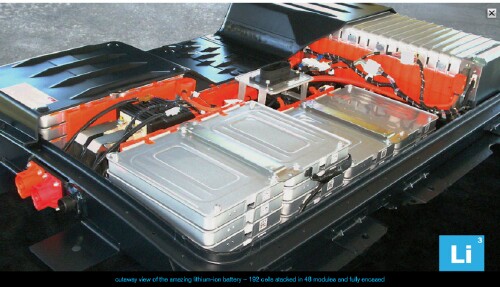 |
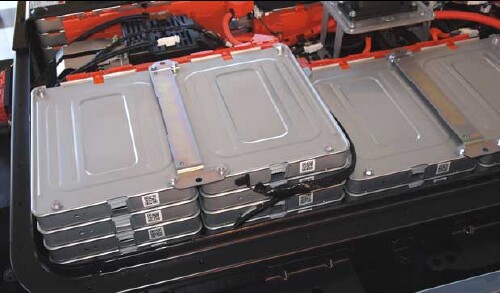 |
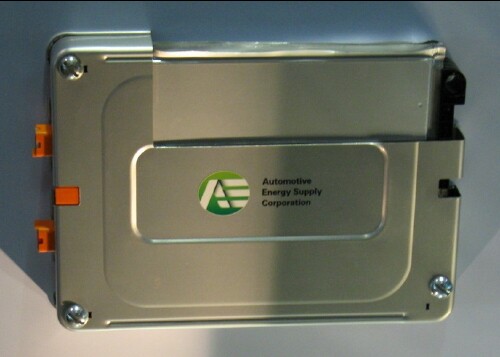 |
Behind the front seats is a battery-cutoff switch for use in emergencies:
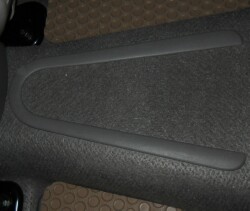 |
 |
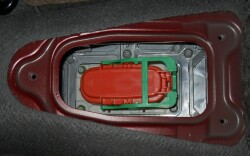 |
|
From http://www.mynissanleaf.com/viewtopic.php?f=31&t=6116&hilit=turtle+dead&start=79 :
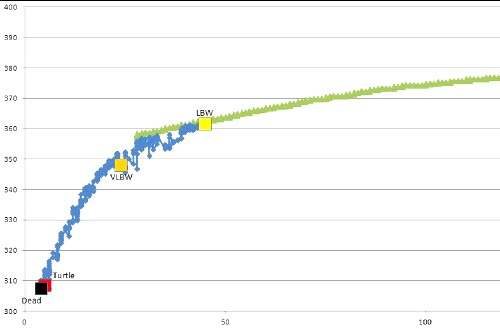
Blue is charging and green is driving.
This is a plot of battery voltage vs gids (1 gid = 0.08 kwh). LBW = Low-Battery Warning, VLBW = Very-Low-Battery Warning; Turtle is where the LEAF goes into a crawl mode. Note that Dead occurs before the battery is fully discharged.
Maximum gids is 281 = 22.48 kWh which leaves 1.52 kWh at the top of the 24-kWh battery charge to make the battery live longer. Since Dead = ~0.32 kWh, the usable energy = ~22.16 kWh. However, one should not go below LBW, which corresponds to ~18.9 kWh usable energy. One definitely should not go below VLBW, which corresponds to ~20.6 kWh usable energy.
The author uses 20% (56.2 gids or ~4.1 kWh left; usable energy ~16.5 kWh) as the target amount of usable charge left at the end of a trip in order to stay above the LBW warning and to allow for an unexpected change of route.
From the owner's manual:
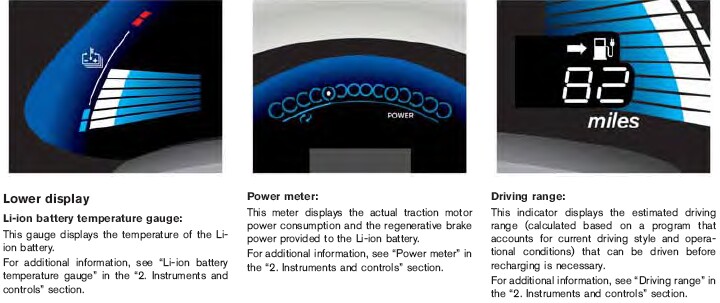
Power meter: Power being used is proportional to the number of the nine circles lighted to the right; battery regeneration power is proportional to the number of the four circles lighted to the left.
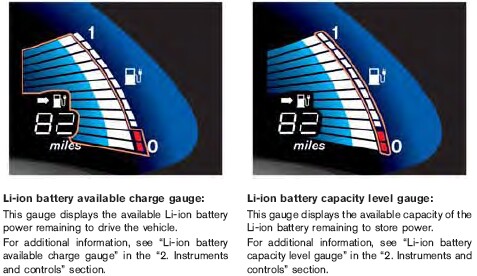
"Temperature affects the amount of
charge the Li-ion battery is capable of
storing. The Li-ion battery is capable of
storing less power when the Li-ion
battery temperature is cold. The Li-ion
battery is capable of storing more
power when the Li-ion battery is warm.
The number of segments illuminated
on the Li-ion battery available charge
gauge can change based on the
amount of power the Li-ion battery is
capable of storing. For example, when
the Li-ion battery becomes colder,
more segments on the Li-ion battery
available charge gauge illuminate because
the available charge is a greater
percentage of the Li-ion battery’s capability
of storing power. When the Li-ion
battery becomes warmer, less segments
on the Li-ion battery available
charge gauge illuminate because the
remaining energy is a lower percentage
of the Li-ion battery’s capability of
storing power."
Segments |
Min Degrees C (F) |
Max Degrees C (F) |
12 |
56 (133) |
none |
11 |
52 (126) |
59 (138) |
10 |
49 (120) |
56 (133) |
9 |
47 (117) |
52 (126) |
8 |
36 (97) |
49 (120) |
7 |
23 (73) |
47 (117) |
6 |
10 (50) |
38 (100) |
5 |
-3 (27) |
27 (81) |
4 |
-5 (23) |
15 (59) |
3 |
-8 (18) |
4 (39) |
2 |
-12 (10) |
2 (36) |
1 |
-15 (5) |
-2 (28) |
0 |
none |
-5 (23) |
It is recommended to NOT quick charge (level 3) charge the battery when the battery is in the red zone.
Nissan states "the pack has a 70 to 80 percent capacity after 10 years."
There also is a 12.8-volts lead-acid boot and accessories battery under the hood. It is charged by the traction battery. On the SL model there is a small solar panel on the back of the roof to trickle charge the 12-volts battery when the Sun is shining on it.
The traction battery charges the 12-volts accessories battery for 5 minutes every 5 days when the car is not being driven. To prevent this drain on the traction battery put a battery tender on the accessories battery.
The charger is in the hump at the front of the trunk. The charging ports are:
 |
 The port on the left is for level-3 (480-V, 125 A) charging; the port on the right is for level-1 (120 V, 12 A) & level-2 (240 V, 30 A) charging. The plug for the right port is an SAE-J1772 standard plug. The plug for the left level-3 port is a CHAdeMO standard plug (up to 62.5 kW). |
Replacement for 2012 portable EVSE ("charging brick") There is a hole under the release handle in which a small 3/16"-shank pad lock can be inserted to prevent the release button from being pushed in to unplug it from the car. There is a way to secure it under the hood by using another extension cord. There is an aftermarket modification to it the allows it to plug into a 240-volts outlet to use it for level-2/240-volts charging at 12 or 16 amps. The 240-volts outlet needed is the NEMA-L6-20R. See Upgraded Onboard EVSE for my Nissan LEAF. The revised portable EVSE that comes with the 2013 LEAF can be changed to 240-volts and run at 4.8 kW. |
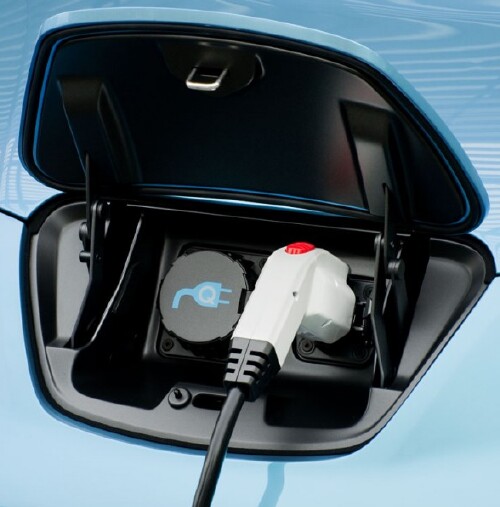 |
There are three blue lights on top of the dash that are visible from the front of the LEAF:
From http://gm-volt.com/forum/showthread.php?8916-New-LEAF-owner-of-less-than-a-week-finds-out-the-cars-a-manual...&p=144386 : " When you Quick charge the Leaf it actually stops at 80%... . The reason for this is by the time it goes from a low SOC to 80% there will be substantial heat build up in the batteries. This is what degrades life more than the charge rate itself."
"Quick charge" means level-3/480-volts charging.
The least expensive way to charge the LEAF at 240 volts is to send the portable charging station (portable EVSE or PEVSE) that is in the container in the trunk to California to have it upgraded to 240 volts: http://evseupgrade.com/styled/. The cost, including a 120-volts pigtail for trickle charging, is ~$340. The upgraded 2013 PEVSE provides power at 4.8 kW for the 2013 LEAF. A more-expensive standard 240-volts EVSE mounted on a garage wall or on a parking-lot pedestal provides power at 6.6 kW for the 2013 LEAF (3.3 kW for the 2012 LEAF. The upgraded 2012 PEVSE provides power at 3.3 kW, the same as the more-expensive standard EVSE.
Then one can get a NEMA L6-20R 240-volts receptacle at Lowes for ~$17 and install it in a garage. There are waterproof versions of this receptacle: Hubbell HBL2320SW and Bryant 70620MBWP.
I did this for my 2012 LEAF and had the outlet installed at my 2 daughters’ driveways in waterproof boxes.
I got the Schneider 240-volts charging station online from Home Depot for $799 and paid an electrician $287 to install it. I wanted to leave the PEVSE in the trunk to always have it there when traveling. It provides power at 6.6 kW for the 2013 LEAF, ~27% faster than the upgraded PEVSE (4.8 kW).
From the owner's manual:
"NISSAN recommends that you connect the normal charge cable when getting out of the vehicle, even if it is not going to be used. By doing this, you can get the most out of the remote climate control and Climate Ctrl. Timer functions the next time you use the vehicle."
"Allow the vehicle and Li-ion battery to cool down after use before charging."
"Avoid leaving your vehicle for over 14 days where the Li-ion battery available charge gauge reaches a zero or near zero (state of charge)."
"The power switch can be set to ON
position and the climate control and
navigation system can be used while
the Li-ion battery is charging. However,
because these operations consume Li-ion
battery power, it will take longer for
the Li-ion battery to become fully
charged."
"During charging, it is possible that the radio may be inaudible due to noise by the electromagnetic wave."
Level-1/120-volts AC |
73% |
Level-2/240-volts AC |
84% |
Level-3/480-volts DC |
90%+ |
There is an aftermarket display that, when attached to the OBD2 plug under the dash, reads out the State-Of-Charge (SOC):
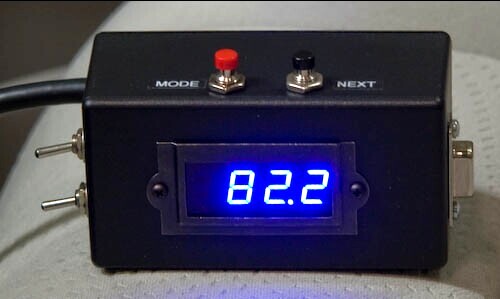
Red button changes modes. Black button changes values for a mode.
Toggle switches: Top one is for the device to be always on when up and only on when the car is running when down. Bottom one is to switch between data buses; currently only switch down bus is being used.
I mount it on the ledge just behind the top of the center console.
I find this device to be a great help when taking long trips on which the battery is near
depletion at the end; it is a more reliable indicator than the “miles to go” LEAF
indicator of what speed should be driven to get to the destination. Combining its
reading with the navigation’s “distance to go” and the LEAF’s “miles to go” help get
there without running out of charge. Every LEAF driver should have it!
Another similar device, LEAFSCAN, that gives 2 more decimal places for the battery
percentage is being developed:
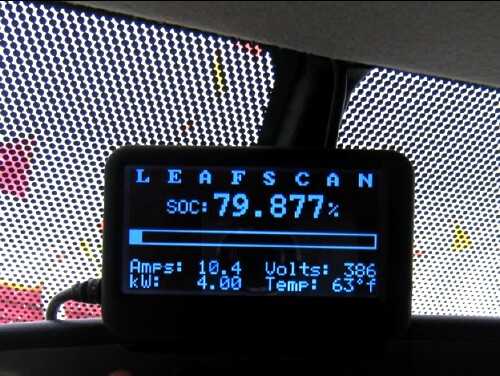
Another similar device, WattsLeft, has 15 different screens:
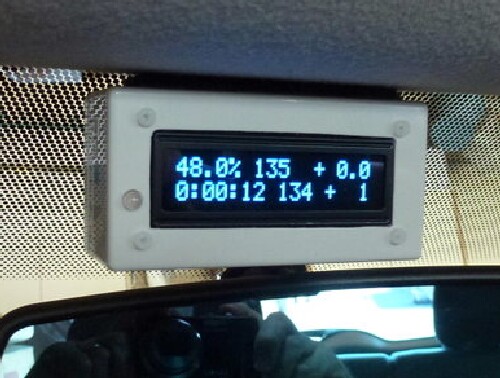
Nissan dealers have two 240-volts (level 2) charging stations for customers to use. However, they are controlled by the dealer and, in some cases, LEAF owners have been barred from using them at a dealer from whom the LEAF was not purchases. If you are planning to use a charging station at a Nissan dealer where you have not been before, call ahead to ask if you are allowed to do that.
A button on the steering wheel shows charging stations within the driving range:
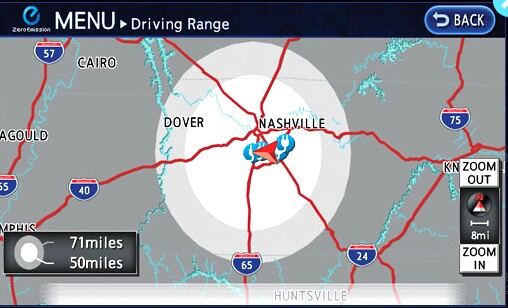
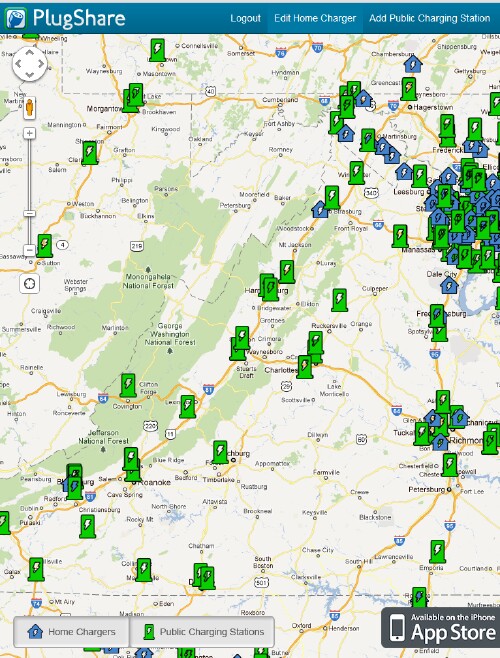
Nissan develops 10-minute electric car charger.
When the LEAF is in Drive Mode, repeating the motion that put it in Drive mode will put it in ECO Mode. ECO mode reduces the available acceleration, provides more energy regeneration when decelerating/braking and reduces power to the heater and air conditioner. Driving in ECO mode reduces energy usage by about 10%.
The ECO mode is recommended for city driving.
In Drive mode the acceleration is high: 0-60 mph in ~9.2 seconds ( http://www.mynissanleaf.com/viewtopic.php?f=8&t=5265 ) ; it is reduced in ECO mode, there is a slight hesitation at the start of acceleration. 0-10 mph is head snapping because electric motors have almost instantaneous torque. Here are graphs that show the differences between Drive and ECO modes:
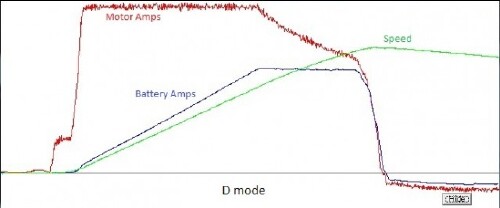 |
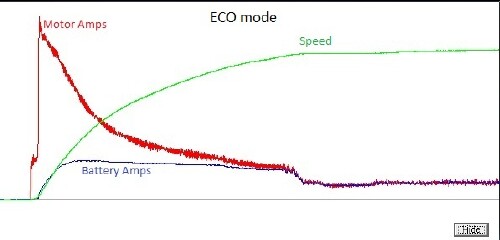 |
The scales are different for the two graphs. |
http://livingleaf.info/2011/09/what-does-the-eco-drive-mode-really-mean-on-the-nissan-leaf/
This mode became available in 2013. There are four driving modes:
Changing modes can occur at any speed.
![]()
Nissan needs to put a feature in the navigation that will take account of the total elevation changes and speed limits for a selected route, and the atmospheric and interior temperatures. (Use of the radio would probably be negligible, but could be included. Same for heated seats and steering wheel.) Those data could be used to do a calculation of the percent of the battery charge that will be required for that route driven at the speed limits. A feature should be to add in a certain number of hours of level-2 charging during the trip.
Here is some good advice on driving the LEAF:
"Watch the number of blue and white bars which surround the miles-left “guessmeter”. That is your equivalent of a "gas gauge". And, like most cars, there is a "reserve" after the gauge tells you the battery is empty. At some point, probably while you still have one bar showing, you will hear a message telling you your battery is low. If you drive slowly and carefully you should be able to get another 15 miles or more out of the battery after that, but unless you are close to home you should treat that as a suggestion to slow down, and if you are on the freeway you should probably get off soon."
"Perhaps ten to twelve miles of cautious driving after that you will get a second verbal warning that your battery is very low. Now you need to start thinking very seriously about finding a place you can get some electricity. You can probably go about half as far after that second warning as you went between the first one and the second one, but you normally shouldn't count on using that range. It might possibly be hard on the battery, and it's definitely hard on your nerves. The final warning is turtle mode, but you don't want to go there. If you see the red turtle on your dash, quickly find a safe place to get off the road, and stop. It's time to call 877-NO GAS EV for help."
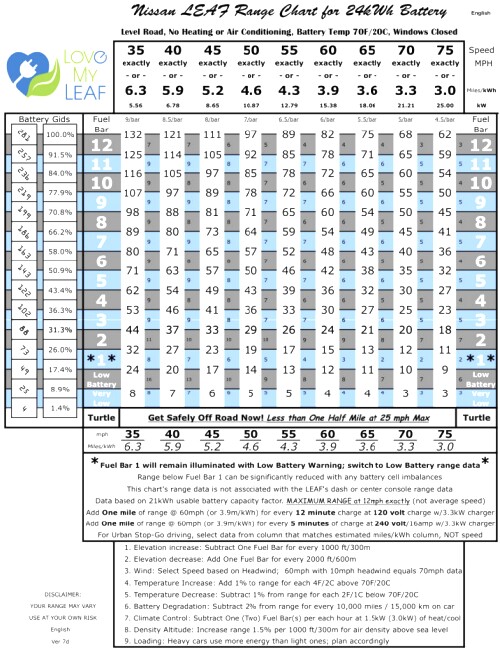 |
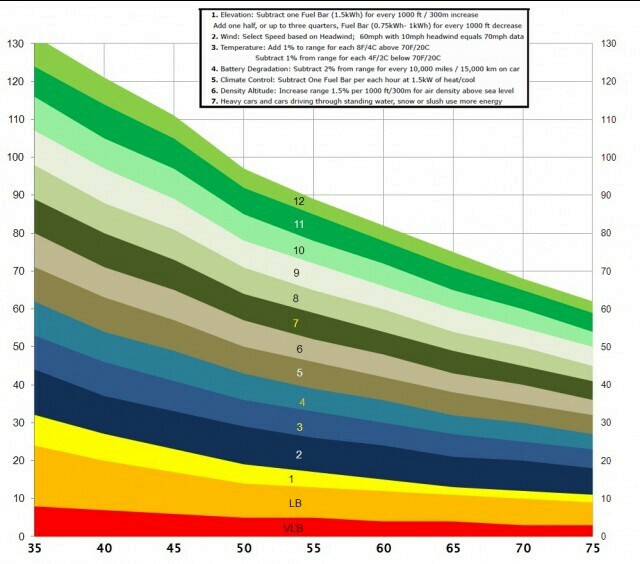 |
This shows range in miles for the 12 bars versus mph. LB = low battery, VLB = very low battery.
A LEAF owner can do the following using an Internet web page or a Nissan-LEAF smart-phone app (iPhone or Android smart phone):
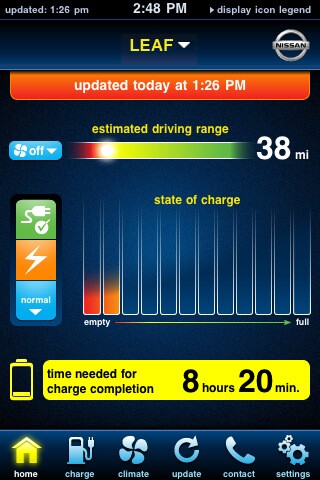 |
 |
From Nissan-LEAF customer information when ordering:
"Cellular Network. The CARWINGS system communicates through the AT&T cellular network which may not be available in all areas. Certain remote functions require a compatible smartphone, not included or supplied."
A detailed account of climate control differences between most cars and the LEAF.
From Nissan-LEAF customer information when ordering:
"The Nissan LEAF™ is equipped with several data recorders:
The Nissan LEAF™ records data concerning various vehicle systems, location, driving performance, and operating conditions. Some of this data is transmitted to Nissan through the vehicle onboard CARWINGS (telematics) system. This data is used for the provision of CARWINGS services, as well as for analysis and research by Nissan designed to, among other things, optimize performance of future electric vehicles including improvements in future battery life. Certain state laws restrict access to such data without the consent of the vehicle owner. Without your consent, the vehicle will de-activate the vehicle telematics system in your vehicle, and certain features, including all telematics, of your vehicle will not operate as intended."
There is an aftermarket display that, when attached to the OBD2 plug under the dash, reads out the State-Of-Charge (SOC):
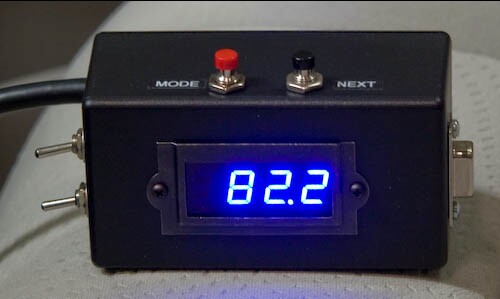
Red button changes modes. Black button changes values for a mode.
Toggle switches: Top one is to turn the device on when up. Bottom one is to switch between data buses; currently only switch down bus is being used.
The 2013 Nissan LEAF shows the battery percentage to 1% accuracy on the display behind the steering wheel:

Also, note the ECO button on the right side of the steering wheel. A new higher-regeneration driving mode called B is on the shift knob where ECO is for the 2012 LEAF.
From Nissan-LEAF customer information when ordering:
"Roadside Assistance and CARWINGS Telematics Features are included through a subscription service which is standard in the price of the vehicle for the first 36 months. After that time, a subscription service can be purchased."
From http://www.nissan-zeroemission.com/EN/LEAF/interview03_01.html:
"We designed LEAF with the environment in mind, adopting vigorous recycling measures. Nearly all the car's components can be recycled after use. Nissan cars already boast a high recycling ratio-over 95 percent-and we expect LEAF to be at the top level among them.
We've also made use of special recycled materials. For example, LEAF's seat covers are made of woven material produced from PET plastic bottles, and many components used in the interior are also made of recycled plastic. The material used for the bumpers comes from recycled car bumpers....the EV's battery boasts extremely high performance, so even when it can no longer run a car it can still be used for other purposes. For example, it could be used as a storage battery for a solar power generator. We are always thinking in terms of ways to reuse these power cells. Eventually, of course, even these batteries will degenerate, so at the very end they will wind up being recycled."
http://www.greencarreports.com/news/1079955_nissan-leaf-to-home-power-station-will-it-make-it-to-u-s
There are some mistakes in some of these reviews:
"
It is not clear to me how important Quick Chargers will be to adoption of electric cars. First, the Leaf is the perfect commuter car but a very impractical road trip car since we would have to QC EVERY HOUR to travel any distance at freeway speeds. Second, QC is not good for the battery. Third, there will never be enough Quick Chargers to insure that there is no extra waiting time, so planning travel using QC will always be a gamble.
The Leaf is the perfect family second car for in-town commuting. I don't plan to ever use QC-- If I need to travel beyond the Leaf range I would take the ICE car. I think talking about QC does a disservice to the marketing of the Leaf-- customers are lead to believe that they should wait for the infrastructure that most of them don't need in the first place." Change "ICE" to "hybrid".
Nissan now says that Quick charging many times a day is ok.
The streamlined 21,000-tons ship City of St. Petersburg transports Nissan LEAF cars from Japan to other countries. It should cut consumption of diesel fuel by 800 tons per year, which would emit 2500 tons of CO2 per year.
Parts missing in an electric vehicle:

Not shown are the missing-transmission parts.
Only one reason to drive an electric car!
Disassembly of Nissan LEAF motor and electronics
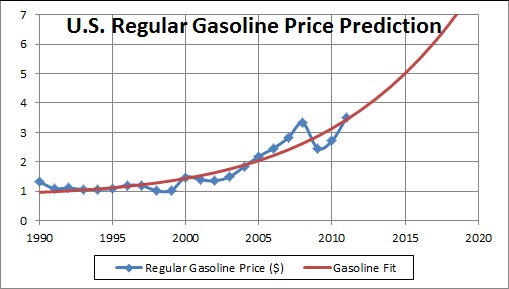
Only one reason to drive an electric car!
In late January the I was allowed to drive the demo LEAF at New River Nissan for five days (~320 miles).
On 3 February I ordered the SL model of the LEAF in cayenne red:
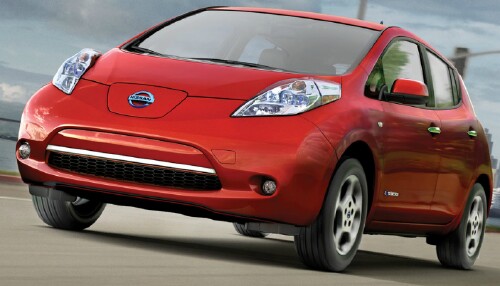
I was told that it takes 90 days to get it. I informed Nissan that I wanted to get my own level-2 charger, as I want one that shows kWh put into the battery. The one Nissan sells does not have a kWh meter nor a charging-time meter. However, one can look at the SOC bars shown in the car dash before and after charging to tell how many kWh have been put into the battery; each of the 12 bars represents 2 kWh.
The charger I selected is sold by Home Depot:
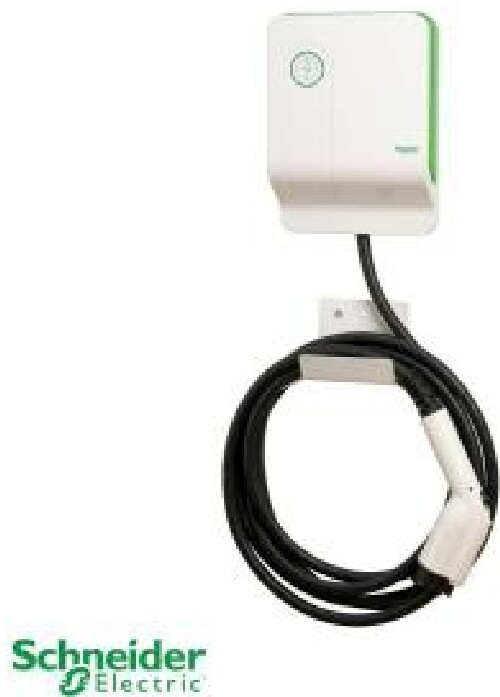
It has an LED that shows how long charging has occurred.
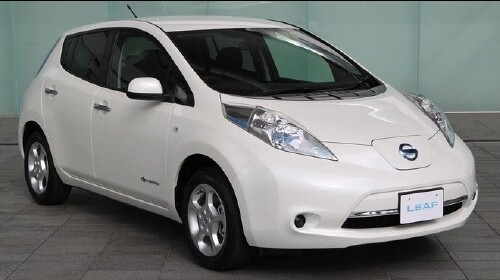
L. David Roper interdisciplinary studies
http://www.roperld.com/science/ElectricCarsMusings.pdf
L. David Roper, http://www.roperld.com/personal/roperldavid.htm
21 January, 2017